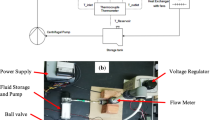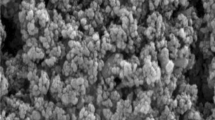Abstract
Stable nanofluids based on DG-100 grade carbon black and carbon nanotubes have been prepared, and their influence on the maximum heat-transfer capacity and thermal resistance of closed-loop two-phase thermosyphons (TPTs) intended for electronics cooling have been studied. A more than twofold increase in the critical heat flux of these TPTs as compared to those filled with water has been obtained along with a sharp decrease in their thermal resistance. It is suggested that this effect is not only due to the high thermal conductivity of the proposed nanofluids, but is also related to the formation of a specific porous structure hindering the appearance of a vapor film and enhancing the boiling process.



Similar content being viewed by others
REFERENCES
L. S. Pioro and I. L. Pioro, Industrial Two-Phase Thermosyphons (Nauk. Dumka, Kiev, 1988; Begell House, New York, 1997).
M. K. Bezrodnyi, I. L. Pioro, and T. O. Kostyuk, Transfer Processes in Two-Phase Thermosiphon Systems. Theory and Practice (Fakt, Kiev, 2005) [in Russian].
V. Yu. Kravets, E. N. Pis’mennyi, and V. I. Kon’shin, Zbir. Nauk. Prats SNUYaE, No. 4 (32), 39 (2009).
S. K. Das, S. U. S. Choi, W. Yu, and T. Pradeep, Nanofluids: Science and Technology (Wiley-Interscience, New York, 2007).
H. Kim, Nanoscale Res. Lett. 6, 415 (2011).
B. I. Bondarenko, V. N. Moraru, S. V. Sidorenko, D. V. Komysh, and A. I. Khovavko, Tech. Phys. Lett. 38, 856 (2012).
B. I. Bondarenko, V. N. Moraru, S. V. Sidorenko, and D. V. Komysh, Tech. Phys. Lett. 42, 677 (2016).
T. Paramatthanuwat, S. Boothaisong, S. Rittidech, and K. Booddachan, Heat Mass Transfer 46, 281 (2010).
Q. Baojin, Z. Li, X. Hong, and S. Yan, Energy Convers. Manag. 50, 2174 (2009).
H. Imura, H. Kusada, J. Oyata, T. Miyazaki, and N. Sakamoto, Trans. Jpn. Soc. Mech. Eng. 22, 485 (1977).
A. Kamyar, K. S. Ong, and R. Saidur, Int. J. Heat Mass Transfer 65, 610 (2013).
K. Sarathi Shankar, B. Suresh Kumar, A. Nandhakumar, and C. Narendhar, Int. J. ChemTech Res. 9, 239 (2016).
V. P. Isachenko, V. A. Osipova, and A. S. Sukomel, Heat Transfer (Energiya, Moscow, 1965) [in Russian].
Author information
Authors and Affiliations
Corresponding author
Additional information
Translated by P. Pozdeev
Rights and permissions
About this article
Cite this article
Bondarenko, B.I., Moraru, V.N., Kravets, V.Y. et al. The Effect of Nanofluids on the Heat-Transfer Capacity of Miniature Thermosyphons for Electronics Cooling. Tech. Phys. Lett. 45, 299–303 (2019). https://doi.org/10.1134/S1063785019030234
Received:
Revised:
Accepted:
Published:
Issue Date:
DOI: https://doi.org/10.1134/S1063785019030234




